So, there was this one late-night jam session. I, Robert Williams, found myself in a musical crossroads, fumbling with my notes on the fretboard. Out of the blue, a melody, swaggering and provocative, punched through the strain. It was the Dorian scale. I was hooked. However, my journey to master the alluring, enigmatic Dorian scale on the guitar, just begins here.
Did you know I unearthed an intriguing reality during my encounters with Dorian mode? No more than 10% of guitarists understand and employ this scale effectively. You may be questioning, why so? We’ll get into that and much more.
Here’s a daring assertion: the Dorian scale is the ‘unsung hero’ of guitar scales. It gets elusive sometimes, yet it is invaluable. The assumption might sound audacious, and I can see some eyebrows raised. Well, allow me to explain.
Infusing your contemporary improvisation with the Dorian scale on the guitar can introduce a new depth to your musical expression. It can convert those predictable solos into engaging narratives. As we delve deeper, my experiences and insights will guide you to navigate the complexity and beauty of the Dorian scale, revealing its untapped potentials.
Understanding the Dorian Scale
Dorian Scale in Music Theory
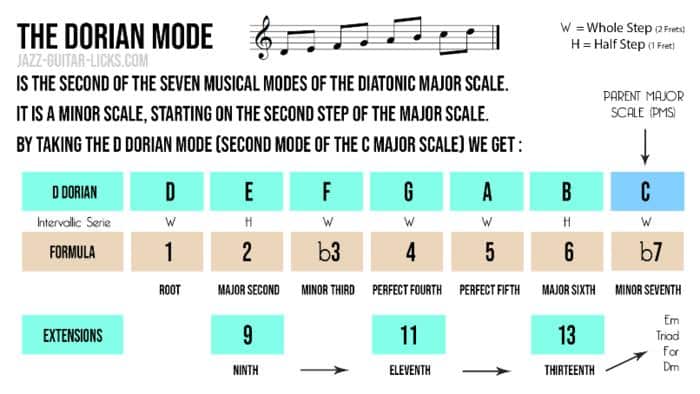
Moving on from understanding the basics of the Dorian scale, let’s delve into its prominence in music theory. Examined as a mode of the major scale, the Dorian scale exhibits unique theoretical principles vital to comprehensive guitar mastery. My rich experience in music theory at the prestigious New England Conservatory of Music empowers me to deliver a streamlined and effective method for exploring Dorian scales and their theoretical foundations.
Music theory elucidates that the Dorian mode is actually the second mode of the major scale. This essentially means that if you were to start a major scale from its second note, and continue to the note of the same name an octave higher, what you’ll have is a Dorian scale.
Recognizing the Dorian mode’s theoretical position within the major scale is paramount. It demystifies how and why the Dorian scale showcases certain sonic characteristics. Understanding the mode’s relationship to its parent major scale also lends insight into its potential harmonic and melodic applications.
The Dorian scale is often associated with certain moods and emotional qualities –
some sort of aural picturesque, if you will. Familiarity with its music theory foundations enables you to more effectively evoke these moods and emotions within your playing. Ultimately, this notion serves as an enriching tool to augment your expressive capabilities as a guitarist.
As we move forward, we’ll explore in-depth the inherent features of the Dorian mode, its patterns, and ways of incorporating it into guitar playing. Always remember: the theory you learn here directly translates to the fretboard. Every bit of knowledge you acquire in this section brings you a step closer to truly mastering the Dorian scale.
Distinct Features of Dorian Mode
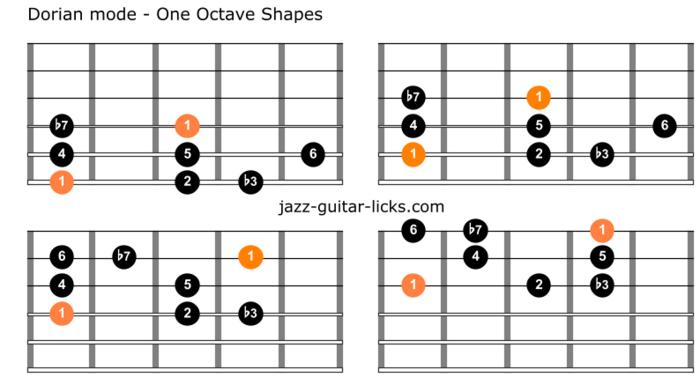
Layered within the murals of music theory, rests the golden thread of the Dorian mode theory, breathed to life and relevance through its unique personality and melodic charm. My years of collecting guitar insights, absorbing countless magazines and engaging in immersive sessions, have enabled me to unveil these distinct features and the vibrant character they paint on the canvas of a tune.
The key determinant of the Dorian mode is its formula. Unlike the easily recognizable major or minor scale, the Dorian mode boasts a specific sequence of intervals: whole, half, whole, whole, whole, half, whole. And just like little puzzle pieces, these intervals interlock to create a minor scale with a raised 6th degree, gifting the Dorian mode its unmistakable sound around which music theory circles.
Yet, the distinctiveness of this mode does not culminate here. Surely every connoisseur of guitar playing will notice that it is the harmonic context that truly brings the Dorian character to center stage. Surrounded by chords extracted from its scale, we create an environment where the mode’s characteristic sonority can thrive. Its sound can be described as minor, indeed, but with a somewhat jazzier or bluesier mood, reflecting its deviation from the standard minor scale.
Moving forward in our journey to master the Dorian scale on the guitar, these unique features of the Dorian mode will guide us like a beacon guiding a ship at sea. With every subsection, we will dive deeper into unearthing these nuances, but keep this in mind – understanding these features is not only about the knowledge, but also about developing a sense of hearing this mode and noticing its colorful presence amidst a piece of music.
Dorian Scale Patterns and Diagrams
Learning Dorian Scale Patterns
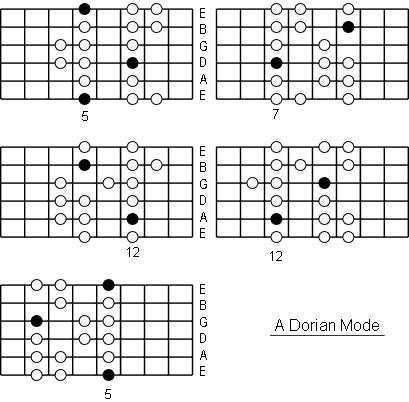
Having dissected the theoretical aspect of the Dorian scale in the previous sections, let’s examine the challenge and reward of mastering Dorian scale patterns on the guitar fretboard. This is a crucial phase of my journey that I’m thrilled to share with you – it’s where theory meets execution and the unique sound of the Dorian mode comes alive.
My years of engraving and personal exploration on the fretboard have yielded invaluable insights that I’m eager to impart. Each Dorian pattern I introduce is drawn from this wellspring of expertise. The key lies in recognizing the central role of the Dorian scale patterns in decoding the cryptic maze of the fretboard. It’s crucial to visualize these patterns as vivid maps guiding your fingers to produce the unique, soulful sound of the Dorian mode.
Embracing the patterns is not about mindless repetition; instead, it’s about immersive, conscious learning. Start by tracing the patterns slowly, then gradually increase your speed. This practice can be likened to learning a new language – at first, you learn the alphabet, then the words, followed by phrases, and soon you are weaving stories and emotions into sentences. Similarly, as you grow comfortable with the Dorian scale patterns, you will start to translate them into melodies and riffs, revealing the Dorian’s beautiful, expressive voice.
These patterns are not just keys that unlock the fretboard, but they robustly contribute to the broader discipline of ‘Dorian Scale Patterns and Diagrams.’ When internalized, they empower you to confidently navigate the fretboard and express your musical ideas freely, marking a pivotal step in harnessing the full potential of the Dorian mode.
With a sound grounding in Dorian scale patterns, we’ll now transition to the next section – ‘Navigating the Fretboard with Scale Diagrams’. Here, we’ll explore how to read and interpret the diagrams, reinforcing your familiarity with the Dorian scale and placing you firmly along the path to mastery.
Navigating the Fretboard with Scale Diagrams
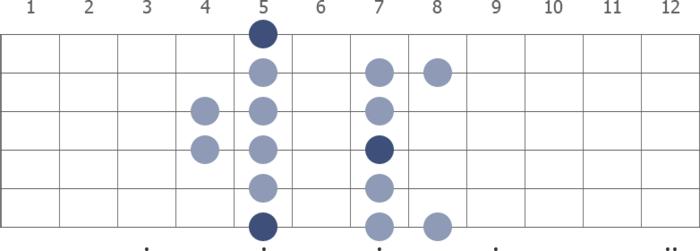
Having spent a substantial part of my career as an editor and transcriber, I’ve formulated a precise understanding of fretboard navigation, particularly within the context of Dorian scale patterns. Applying this expertise, let’s delve into how to use the scale diagrams to navigate the guitar fretboard.
Scale diagrams significantly expedite the process of learning the Dorian scale on the guitar. These visual representations essentially act as a map, illustrating the location of each note within a particular scale across the fretboard. The horizontal lines represent the strings while the vertical lines correspond to the frets. Each dot on the diagram marks the location of a note in the scale. An effective way to practice would be to begin with an open-string note and gradually work your way up the fretboard.
Understanding how to interpret these diagrams is crucial to building confidence in fingering patterns, chord progression and improvisation. It also enriches your ability to transpose music across different keys, vital for versatile guitar playing.
Moreover, integrating scale diagrams while learning the fretboard allows you to unlock a more expressive and creative avenue for your artistry. Rather than being confined to the basic, open-string chords, a good grasp of the fretboard can open a door to diverse voicings, chord inversions, complex riffs, and solos. The practicality and effectiveness of scale diagrams in understanding fretboard navigation are by no means an overstatement.
As we transition into learning to apply the Dorian scale on the guitar, remember that becoming proficient in fretboard navigation with the help of scale diagrams won’t transpire overnight. It requires continuous practice, keen observation, and open-minded exploration. However, this commitment will truly enrich your abilities and lend versatility to your musicianship.
Keep this crucial guidance within arm’s reach as we proceed on this emblematic exploration of the Dorian scale, harnessing the true potential of a comprehensive understanding of scale diagrams and fretboard navigation.
Applying the Dorian Scale on Guitar
Practicing the Dorian Scale
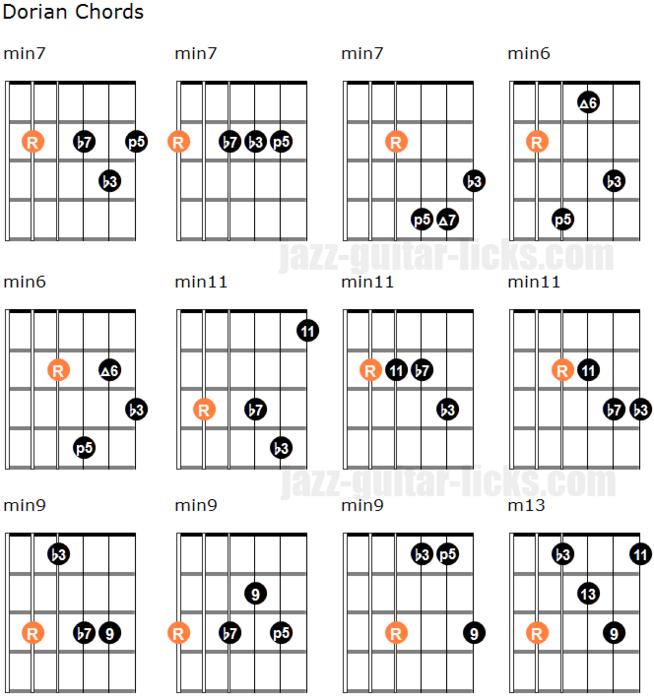
In the realm of ‘Applying the Dorian Scale on Guitar’, practicing the Dorian Scale is a pivotal progression. The exercises and practice methods I’ve come to discuss have personally aided me in mastering this fascinating scale on guitar.
Firstly, deconstruct the Dorian scale and understand its structure. This mentally prepares you for what you are about to engage in. Set a clear and precise routine for your Dorian scale practice that involves methodological repetition – a skill that underpins every proficient guitarist’s daily regimen.
For a unique approach to this, I recommend interchanging guitar scales during your practice sessions. I found that jumping between Dorian scale forms and other modes proved advantageous for me. It trains your ears and fingers to swiftly adapt to different tonal landscapes, thereby increasing your versatility and musicality.
Additionally, always remember the importance of slowing down during your practice. It might seem counterintuitive, especially when eagerness to achieve fast, fluent runs within the Dorian scale cycle sets in. However, slow practice encourages your fingers to build appropriate muscle memory and your ears to recognise subtle nuances within the distinct Dorian soundscape.
Integrating Dorian-based licks and riffs into your conventional practice routine can also be extremely fruitful. This approach not only familiarises you with the scale but also sets the stage for you to craft your unique solos and song interpretations.
Every musical journey differs. However, a steadfast dedication towards practicing the Dorian scale consistently on the guitar will assuredly lead to a notable improvement in your ability to harness its unique sound. For me, incorporating these practices into my daily routine transformed my understanding and application of the Dorian scale, thereby enriching my overall guitar playing experiences.
Keep evolving and fine-tuning your practice methods as this journey progresses. As the next section of this guide delves into improvisation using the Dorian mode, remember that it is through your diligent practice you can truly master the Dorian scale and seamlessly apply it to your guitar performances.
Improvise with the Dorian Mode

With an in-depth knowledge of the Dorian scale and countless hours of practice under your belt, you’re now ready for one of the most exciting phases of this musical journey – improvisation. In my years of improv work, the Dorian mode has been a cornerstone. I’m eager to share my strategies for leveraging this mode in your own improvisations. Though it may seem intimidating at first, remember that improv is all about letting your creative spirit flourish.
Playing Dorian on guitar allows you to experiment, create unique melodies, and add stylistic flair to your music. Begin by warming up with simple patterns and gradually incorporate complex runs. Play along with your favorite Dorian style tracks or create a loop with backing chords to practice. This mode is especially effective over minor chords, contributing to darker and jazzier sounds.
Effortless improvisation with Dorian mode comes from a deep understanding of its distinct features. Remember to highlight the characteristic raised 6th that separates it from the natural minor scale. This note adds the spice that sets Dorian apart, creating possibilities for tension and release that can make your solos sing.
Guitar modes like Dorian are not isolated concepts. Learning them in context is key to meaningful improvisation. Keep in mind the relation between Dorian mode and its parent major scale, this perspective will open up new avenues for exploration. You may try superimposing Dorian mode over major scale progressions for a sophisticated sound.
Through deliberate practice and thoughtful application, the Dorian mode can be a transformative weapon in your improvisation arsenal. As you continue to grow in your musical endeavors, remember to review these pointers and techniques, always challenging yourself to dig deeper into the vast and complex world that is the Dorian mode.
Let’s move on to the next section and dive deeper into how chords are constructed in the Dorian scale and how we can use them in our musical improvisations.
Chords in the Dorian Scale
Identifying Chords in the Dorian Mode
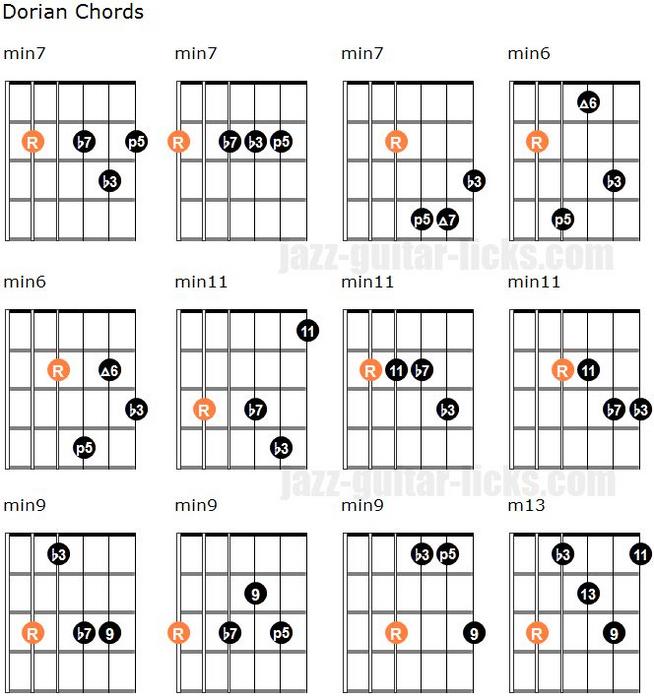
Upon understanding the Dorian scale, exploring its related chords is naturally our next step. Specifically, we are going to focus on identifying guitar chords for the Dorian mode, which, as anyone acquainted with this scale will testify, has its distinct charm.
In the Dorian mode, you’ll often encounter minor chords, a staple of this unique tonal realm. But how do you identify these chords in the context of the Dorian mode? Here’s my method. Mind you, it reflects years of commitment to my guitar and countless hours spent understanding and experimenting with scales and modes.
Take a Dorian scale, say G Dorian. This scale comprises G, A, Bb, C, D, E, and F. To find the chords within this mode, we harmonize each note by stacking thirds. The result? A host of captivating chords, such as Gm (G, Bb, D), Am (A, C, E), and so forth. Notice the minor chords? They truly characterize the Dorian mode’s unique blend of melancholy and intrigue.
Now, to apply this knowledge effectively on the guitar, we have to remember that just like any other scale, the Dorian scale also follows a pattern – a sequence of whole and half steps. Decoding this sequence will help you chart a path around the fretboard, connecting your minor chords seamlessly.
This in-depth understanding of identifying chords in the Dorian mode empowers us to realise fascinating improvisations, something we will explore in the coming section. So, grab your guitar and let’s tread this exciting path together.
Applying Chords in Improvisation
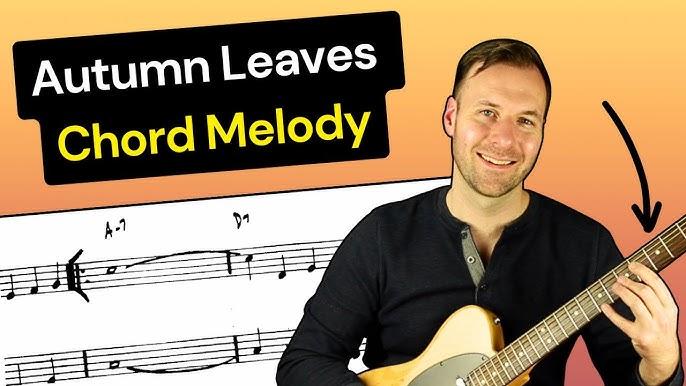
Applying chords in improvisation is a crucial step in mastering the Dorian scale on the guitar. My personal experiences as an improviser and performer will illuminate the practical applications of Dorian chords.
The Dorian mode, as you now know, is simply the Major scale with a minor 3rd and 7th. This tonal shift affects the inherent sound and dominant chords used in improvisation. When I play guitar chords for Dorian mode, I focus on the minor 1st, major 4th, and minor 5th chords. These chords, derived directly from the mode, contribute to the unmistakable Dorian sound.
Knowing the chords is only the first step. Execution in real-time improvisation requires deep familiarity and quick recall. To intimately know your Dorian chords, I suggest practicing drills that involve jumping between random chords in the mode. This helped me to cement them into muscle memory and improved my performance greatly.
Keep in mind, improvisation isn’t just about raw skill. It’s also an emotional expression and a storytelling device. You need to feel and understand the unique appeal each chord brings to a performance. The minor tonality of the Dorian chords, for example, often brings a sense of melancholy – use that to your advantage.
So to wrap up, remember that incorporating Dorian chords effectively in improvisation is a blend of technical knowledge, practice, and emotional interpretation. As we navigate forward to understanding the sound and appeal of the Dorian mode, carry forward these tips to enrich your improvisation skills.
Dorian Mode Sound and Appeal

As someone who has devoted a good chunk of my musical journey to the mysterious realm of guitar scales, I’ve had the pleasure of exploring the captivating universe of modes. And among them, one stands to be profoundly intriguing – The Dorian mode. The sound and appeal of the Dorian mode have endlessly fascinated me as a musician. It possesses a flavour that is distinct and a charm that is undeniably compelling across various music genres. Incorporating and improvising with it into your guitar licks will enrich your performance with a unique musical aura that can utterly mesmerize your audience.
From the moment you strum the strings, the Dorian mode sounds usher in an exciting mixture of emotions. It’s inherently minor, creating a somewhat melancholic feeling, akin to the natural minor scale. Yet, there’s an air of optimism and resilience that punctuates every note, making the Dorian mode uniquely versatile. This sweet balance between the somber and the sublime, the dark and the luminary, truly attests to its appeal.
Have you ever experienced the captivating sound of the Dorian mode in music? Prepare to fall in love. The moment the mode caresses your ear, you’re whisked away into a world of mesmerizing sonorities. I remember the first time this mode grabbed my attention. It was a performance embedded with luscious Dorian mode sounds. The guitar licks enriched with Dorian scales added an alluring freshness that instantly clicked. That hypnotic performance hooked me, and since then, the Dorian mode has been an irreplaceable part of my musical vocabulary.
The balance it strikes, the depth it offers, and the broad emotional spectrum it covers are what make the Dorian mode a gem in the crown of music theory. In the realm of jazz, blues, rock, and pop, the Dorian mode has become a firm favourite among guitarists. It provides the opportunity to weave complex layers of sound, making your guitar sing with richness and variety.
Yet, the Dorian mode isn’t just about the sound. It’s also about the narrative it allows you to express through your guitar. By mastering this mode, you engage in a musical discourse. You tell stories, evoke emotions, and paint vivid landscapes with your notes. It’s a mode that speaks to the heart of the listener, resonating deeply and leaving an indelible mark.
So as we journey further into the captivating world of Dorian scales on the guitar, I invite you to embark on this adventure with an open mind and an ardent spirit. I hope you find as much joy and satisfaction in exploring the Dorian mode as I have over the years. Remember, mastering the Dorian mode is more than just adding a new scale to your arsenal; it’s like acquiring a whole new language to express your musical ideas eloquently.
By the end of this comprehensive guide, you’ll not only be able to proficiently play the Dorian scale but also understand its character, its potential, and its enduring appeal. You will explore the underlying music theory, distinct features, patterns, application, and improvisation techniques related to the Dorian mode. So prepare yourself for a deeply enriching musical experience that will unveil a new realm of possibilities on your guitar.
FAQs
What is the Dorian Scale on guitar?
How can I master the Dorian Scale on guitar?
What are the benefits of mastering the Dorian Scale on guitar?
Conclusion
So what does it truly mean to understand and master the Dorian scale on guitar? As we draw connections back to the main aspects of our discussion, we can conclude that playing Dorian on guitar is not just about learning to navigate the fretboard or recognizing patterns. True mastery lies in understanding its distinct features and the unique sound it brings.
Reflecting on my journey as a guitarist, delving into the intricacies of the Dorian mode has allowed me to deepen my theoretical and practical understanding. Recognizing and implementing the chords within the Dorian scale can take your improvisation skills to the next level.
Practice, they say, makes perfect. Over time, with sustained effort, you will find yourself better able to optimize the Dorian scale. The process can be challenging, yet ultimately rewarding. It adds a zest to your musical palette, unlocking rich harmonic possibilities and a distinctive sonic character.
Remember that in music, there are no shortcuts – just keys opening doors to uncharted territories and offering countless creative possibilities. So, let the Dorian scale be one of those keys for you, a stepping stone towards becoming a more proficient and more diverse guitarist.